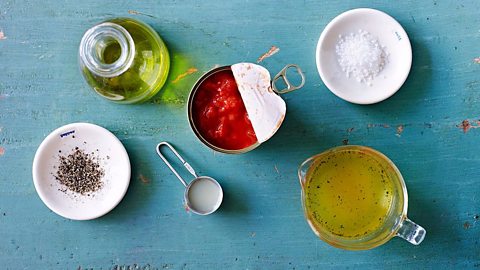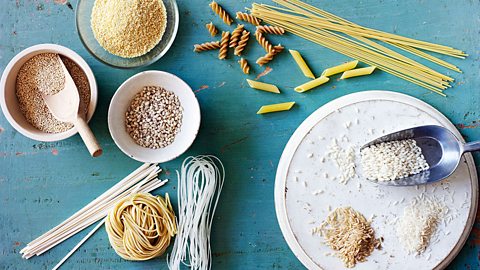How to cook brilliant store cupboard dinners on a budget
The kitchen store cupboard is often overlooked in favour of the convenience of tucking into a ready meal or calling in a takeaway. But with the right mix of dried foods, tins and packets, a filling and tasty dinner is only ever a few minutes away. It takes just a few pounds to stock up your kitchen with the basics, and if you mix and match carefully you'll be able to rustle up a good variety of meals. So which ingredients should you stock up on?

The basics
These six superhero staples should be in every store cupboard.
Tinned tomatoes. Chopped tomatoes are a staple ingredient of many popular recipes β including pasta sauces, curries, soups and chilli con carne. Tinned tomatoes also come whole (plum tomatoes) and sieved (passata), but these options are typically more expensive and less versatile. The trick with tomato-based sauces is to cook them low and slow β even the cheapest tomatoes will taste great if you cook them for long enough. If you like Italian food, consider buying tomatoes flavoured with garlic or basil as they make last-minute sauces super-easy, even if youβre out of garlic.
Stock is used in stews, curries, rice dishes, soups and gravy. It will add extra flavour to couscous and other grains.The cheapest form of stock is cubes. Similar products include jelly pots and concentrated stock in bottles β these are more expensive, but some people prefer the taste. Some readymade stocks are very salty, so choose low-sodium varieties if you are watching your salt intake. If you know a butcher whoβll give you bones for free, you can make your own stock. It takes time, but thereβs very little work involved and it can be frozen in batches.
Cooking oil. Many dishes require oil for cooking, but it doesnβt need to be anything fancy. In fact cheaper oils often do the job better. The most versatile β and affordable β oil is a flavourless one such as vegetable oil or sunflower oil. They donβt burn at high temperatures, so are suitable for frying, plus their mild flavour means they can even be used in baking β both for greasing tins and in recipes. Olive oil tastes good, but itβs expensive and has a low burning point, which makes it unsuitable for cooking at high temperatures. If you decide to treat yourself, reserve it for recipes that use it as a flavouring.
Salt. This most basic of seasonings will be required in most savoury recipes and many sweet ones. The aim is to use salt to enhance the other ingredients β not to make food taste salty. There are lots of different types of salt available, but for most people table salt (or coarse sea salt if you have a grinder) is all that's needed. Flaked sea salt is very popular with chefs because it dissolves easily and adds a crunch to finished dishes. If a recipe calls for flaked salt and you only have table salt available, use about half as much as the recipes states. Smaller crystals sit closer together, meaning each pinch contains more actual salt.
Pepper. Like salt, pepper enhances the taste of other ingredients. It adds a spicy warmth and is especially important when cooking creamy dishes and meat. Pepper should be added towards the end of cooking as it loses flavour when cooked. Black and white pepper can be used interchangeably, though they do have a slightly different flavour. Freshly ground pepper has more depth of flavour than ready-ground, so itβs worth investing in a pepper grinder if you donβt already have one. Whole peppercorns can also be much cheaper than ground pepper if you shop around.
Lemon juice. This makes it onto the list because its acidity can transform many different dishes. Fresh does taste best, but a bottle is cheaper, lasts longer and does the job. Use it in risottos, sprinkled onto fish, rice and green vegetables, mix it with oil and spices to make marinades that will tenderise tough meat, whip up a basic salad dressing or use a few drops to enliven overly rich or bland sauces, stir-fries and casseroles. Vinegar can be used in a similar way, but it isnβt as user-friendly because there are many different types and each one has a distinctive flavour.
Tinned foods
Tinned foods tend to be cheap and have a long shelf life, but they also retain a lot of nutrients and often compare favourably with fresh foods. They can be used to make all manner of quick, healthy dishes, so don't limit yourself to baked beans on toast!
Beans and pulses are very nutritious and a useful standby for last-minute dinners such as spicy bean wraps, sausage casseroles or veggie stews. Dried beans and pulses can be much cheaper, but tins are still cheap compared to most foods. Dried versions often need soaking and tins are more convenient.
Tinned vegetables, such as potatoes, are great in Spanish omelettes and stews. Chickpeas and spinach are both great in curries. Try to buy tinned vegetables in water, rather than brine, which contains a lot of salt.
Tinned fish. Tuna is a popular choice, but you can now buy everything from pilchards to lobster in tins. Try sardines on toast or with pasta. Anchovies add fantastic depth of flavour to sauces.

Starches
Starchy foods such as pasta and rice should make up about a third of your diet according to the NHS eatwell plate. As well as being good for you, they are cheap and store well in air-tight containers. Here are some tips on what types to buy and how to use them:
- For a quick dinner, dried pasta is unbeatable. Learn one or two store-cupboard sauces and youβll always be able to whip-up a meal. The shape of pasta required depends on what you like to cook. To bulk out soups, use tiny pasta shapes. For thin sauces, try spaghetti or penne. If you like chunky sauces or bakes, go for larger shapes such as rigatoni and farfalle. Brown pasta is better for your health, though it takes a little longer to cook. Good ingredients to keep in stock for pasta dinners are tinned fish and sweetcorn, olives, capers and preserved vegetables in oil, such as artichokes and peppers.
- Noodles come in many shapes and sizes β they are all quick to cook and very versatile. Use them in soups, sauces and stir-fries. The most common in the UK are egg noodles, which can be used in stir-fries or alongside meat and vegetables. Thin varieties, such as rice noodles, are usually served in South-East Asian soups and salads. Frozen prawns and tofu are great ways to add protein without relying on fresh produce.
- Rice. As a rule of thumb, the shorter the grain the more absorbent the rice will be. For fluffy, separate grains, use long-grain varieties. Medium grains absorb more liquid, so are used in risottos and paella. Short grains make sticky rice β ideal for puddings.Long-grain rice is the cheapest variety. It benefits from thorough rinsing with cold water before cooking β particularly if using the cheapest brands. Use cold, freshly cooked rice to stuff vegetables or make special fried rice.
- Other starches to try. Couscous is very easy to cook: a bit of measuring and then simply soak it in boiling water. Serve it in salads, or with stews and grilled meat. Bulgur wheat can be used in the same way, but is more expensive. Quinoa is relatively expensive, but a useful high-protein standby. Itβs easy to cook, with a mild nutty flavour. Pearl barley has little flavour, so can be used in soups and stews as a thickener. Try it as a low-cost alternative to risotto rice. Oats are a good store-cupboard ingredient for sweet dishes. Use them to make flapjacks, in a quick and healthy crumble topping, or add them to cookies and muffins.
Frozen ingredients
The freezer section of supermarkets stock a lot of processed food, but there are some great value gems to be found. A well-stocked freezer can make life much easier, providing healthy, balanced meals in minutes.
- Frozen vegetables. Stock up on peas, onions and mixed vegetables so youβll always have options for healthy meals. Frozen sweetcorn is better than tinned because you can use the exact amount you need without being restricted by the tin size.
- Frozen fish and seafood. Cook-from-frozen fish fillets are a healthy standby. Seafood mixes make great fish pies, chowders and pasta dishes.
- Meat and meat substitutes. Try cook-from-frozen mince, or diced meat for stir-fries, wraps and curries. Quality varies, but frozen doesn't equal bad (for instance, many good butchers sell frozen meat).
- Frozen fruit. For sweet treats, frozen fruit makes great crumbles and smoothies. Over-ripe bananas can be frozen and made into healthy ice cream.
Other things to consider are frozen fresh herbs, root ginger and chillies: it's not the cheapest way to buy them, but it makes sense if you use them infrequently. Frozen mash makes many family-favourite meals easier and ready rolled puff pastry can be used to make cheat's pizzas or turn leftover stews and casseroles into pies.